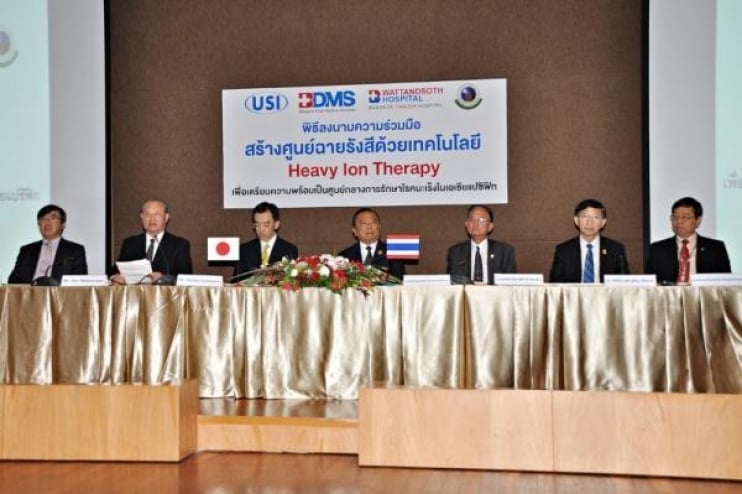Bangkok Cancer Hospital Wattanosoth, together with Universal Strategy Institute Limited Liability Company of Japan, has signed a cooperation agreement to establish a radiation center using “Heavy Ion Therapy” technology, which is considered a modern and effective radiation treatment technology for cancer and tumor patients. This treatment uses a shorter duration, has fewer side effects, and is suitable for patients who are not suitable for traditional radiation treatment or those who have not achieved successful results from traditional treatments.
Dr. Chatree Duangnetr, Director, Vice Director, Chief Operating Officer of Bangkok Dusit Medical Services Public Company Limited, and President of the Bangkok Medical Center, stated that the signing of this cooperation to create a center for radiation treatment with Heavy Ion Therapy technology marks another step forward for the medical community in Thailand. This effort is academically supported by a non-profit international organization for radiation medicine from Japan (NPO Japanese Organization for International Cooperation In Radiation Medicine) and Siriraj Hospital.
In 1993, the National Institute of Radiological Sciences (NIRS) in Japan constructed and installed a heavy charged particle accelerator for medical use and succeeded in treating cancer with carbon ion radiation. This was officially certified in October 2003 by the Ministry of Health, Labour, and Welfare, Japan, under the title “Solid Tumor Treatment with Heavy Ion Therapy,” which is part of an advanced technology treatment program supported by the Japanese government. NIRS has treated many patients, achieving significant success.
The five-year survival rates for various cancers are as follows: prostate cancer 95%, non-small cell lung cancer stage one 70%, bone cancer in areas adjacent to the spine and pelvis 50%, broad or recurrent type liver cancer 50%, advanced stage cervical cancer 45%, etc. Currently, there are 7 institutes worldwide with Heavy Ion Therapy technology: 4 in Japan, 1 in Germany, 1 in Italy, and 1 in Shanghai. Bangkok Cancer Hospital Wattanosoth will be the eighth to establish a center using “Heavy Ion Therapy.”
Assoc. Prof. Dr. Teerawut Kuhaprema, the director of Bangkok Cancer Hospital Wattanosoth, further explained that Heavy Ion Therapy uses heavy particles such as carbon, neon, and argon (heavy ions) for radiation treatment. Carbon Therapy, which mainly utilizes carbon ions, is the most widely used, as heavy ions can discharge almost all their energy at the desired depth, allowing a high radiation dose to cancer cells and tumors while minimizing radiation to surrounding normal tissues. Moreover, heavy ions have 2 – 3 times greater ability to destroy cancer cells than conventional radiation, being a subtype of particle therapy.
Particle Therapy is divided into 2 main types:
- Proton Beam Therapy (PBT), where protons are derived from the separation of hydrogen ions, and Heavy – Ion Beam Therapy mainly uses carbon atoms for treatment. The duration of carbon treatment can reduce the treatment time by half, and the amount of radiation received by surrounding normal organs is less than that with proton beam therapy.
- Particle Therapy is a widespread treatment method in Japan, involving the use of high-energy nuclei of heavy elements such as protons, carbon, argon, etc., for cancer and tumor radiation treatment. These high energies are generated by inducing particles with magnetic force to separate positive and negative charges to obtain the desired charge or to create suitable particles, which are then accelerated by synchrotron or cyclotron accelerators to the speed of light, merging the charges into a radiation beam for treatment.
The difference between particle therapy and the photon beam group (which includes both gamma rays and X-rays, commonly used in current radiation treatments), is that photon beams are high-energy electromagnetic waves that gradually release energy as the beam moves from the skin surface to the desired tumor, destroying cells in its path. In contrast, particle beams are high-energy particles that are not waves, discharging most of their energy at a determined depth and location, thus reaching deep body parts with minimal destruction to good cells they pass through.
The advantage of particle therapy is its high precision and accuracy; the radiation can destroy cancer cells at the desired depth and location with the appropriate radiation dose, making it suitable for patients who cannot undergo surgery or those with high surgical risks, as well as patients who refuse surgery. Since the radiation discharges almost all its energy at the specific location, the amount of radiation entering the body has minimal impact on healthy cells.
Moreover, cancer cells or tumors are destroyed precisely at the target. Thus, particle therapy is suitable for children at risk of secondary malignancy due to radiation, patients who may have high side effects from conventional radiation treatment, and patients with tumors located near organs at high risk from radiation.
Additionally, one advantage of heavy ion treatment over proton therapy is that it is particularly beneficial for patients with radioresistant cancer types, as heavy ion treatment is more effective in destroying cancer cells than photon beam radiation (Photon Beam) or proton therapy (Proton Therapy).

